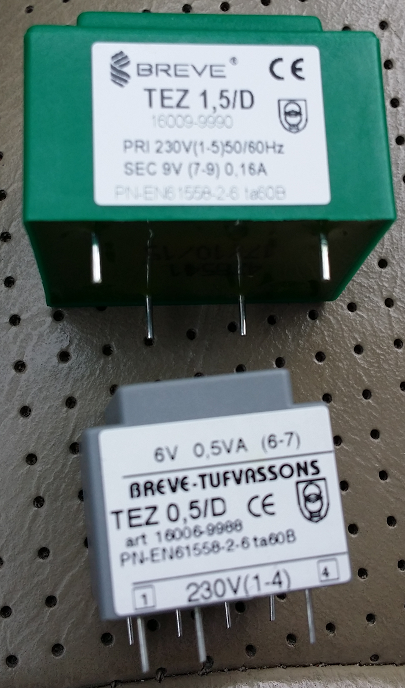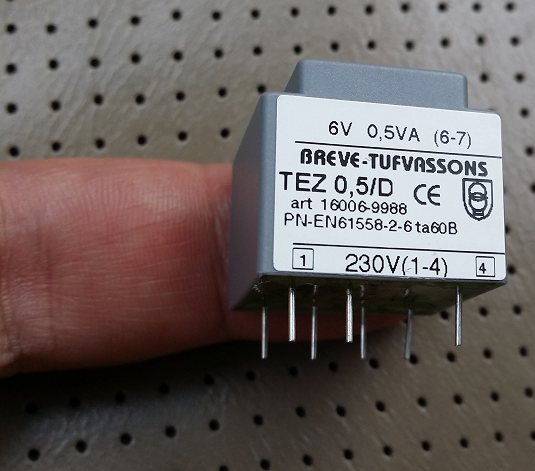Encapsulated transformers instead of traditional switching power supplies like Hi-Link
-
Has anyone tried to use small transformers for PCB mount like this as power supplies?
$2.09 without shipping costs, AC 6V voltage, 58 mA: https://www.aliexpress.com/item/PE2006-M-Power-0-35VA-220V-6V-Expory-resign-encapsulated-safety-isolating-transformer/32688201552.html
This transformer suits low-power nodes. There is a lot of models for different power requirements.
Transformers are very small (22x23x15 mm, comparable to commonly used HLK-PM01 - 15x34x20 mm), but it's requied to use rectifier, capacitor and linear regulator.
As for me such transformers are much safer (fire-proof, reliability, safety - full galvanic isolation) then using 24x7 instead of switching power supplies. UPD: Also such power supplies produces much lower high frequency electromagnetic noise.
What are advantages and disadvantages of using such transformers?
-
Just bought yesterday in our local store two types of small transformers:
13 PLN ($3.18) - 0,5W 230V => 6V 0,083A, 18,5 x 21,5 x 22,5 mm very small
10.5 PLN ($2.57) - 1,5W 230V => 9V 0,16A , 22 x 32 x 27 mm slightly largerI will try/test transformers in the next few days.


-
This post is deleted!
-
I'm definitely not an expert on this, but here's my two cents: In very few countries (such as here in Brazil), we have both 220V/110V, it depends on the city where you live. So the switching PSU are more convenient for small electronics.
You also need a bit more time/efforts to assembly (as you need the rectifier bridge, capacitor, regulator etc). Also a bit more space maybe.
But the 'fire-proof' and 'galvanic isolation' sound as very good arguments --- I look forward to see your results...
-
I'm definitely not an expert on this, but here's my two cents: In very few countries (such as here in Brazil), we have both 220V/110V, it depends on the city where you live. So the switching PSU are more convenient for small electronics.
You also need a bit more time/efforts to assembly (as you need the rectifier bridge, capacitor, regulator etc). Also a bit more space maybe.
But the 'fire-proof' and 'galvanic isolation' sound as very good arguments --- I look forward to see your results...
@rvendrame transformers often contain two 115V windings (but not the ones that I bought), so you can connect one of them to use in 110V environment or connect both windings in series to use in 220V environment.
As for time and assembly size - yes, you are right, but for low power devices it's possible to use very small rectifier bridges (or just two sot-23 two-diode assemblies), and small sot-23 LDO (for examle, very popular XC6206P332MR - 662K). So all them with capacitor(s) will be almost the same size on PCB as well-known Hi-Link switching power supply.
Also, for switching power supples you need external circuits (fuses, varistors, etc), just first two links with example of Hi-Link usage in real world:
https://www.openhardware.io/view/77/AC-DC-double-solid-state-relay-module
https://www.openhardware.io/view/334/MySensors-RFM69W-relay-actuator-nodeOn the other hand, for such small low-power transformers even shortage of secondary winding will not result in problems, this will just slightly heat up transformer.
-
So, as I promised, I'm providing test results of smaller one transformer (6V 0.5VA).
Transfomer output is around 10.0 volts (AC) without load, rectified voltage is about 14.3 volts, DC (IN5819 shottky diode bridge, 16V 220uF capacitor).
Under load (LM7805 + second 220uF capacitor + Arduino Nano with BME280 sensor and NRF24L01 radio, reporting three values (humidity, pressure, temperature) every second, without deep sleep modes) current usage before LM7805 is around 40 mA (I have no oscilloscope, multimeter only), alternating voltage on transformer output under load is around 7.9 AC volts, rectified voltage is around 8.4 DC volts.
Transformer (both without load and with load) is a little hot, a little warmer than the human body (maybe around 40 degrees C).
Test node working great without any issues.
Size of IN5819 rectifier bridge, two capacitors and LM7805 with transformer is comparable with Hi-Link PSU.
I think this is very good solution (safety first) for low-power nodes, including in-wall nodes and so on.
-
Isn't hi-link a little more efficient than a standard transformer? I mean it shouldn't get that warm
@gohan I don't know how to compare efficiency of such different devices.
According to http://lygte-info.dk/review/Power Mains to 5V 0.6A Hi-Link HLK-PM01 UK.html maximum efficiency of Hi-Link is about 70%, but efficiency decreases at low currents down to 40-50%.
If you want I can measure current in input winding (230V) of transformer with load and without load.
-
@gohan 8.3 mA AC at no load, 8.4 mA AC at load (~40 mA DC at low-voltage side), 11.2 mA AC at secondary winding short circuit. 225 V AC mains voltage. About 1.87 VA (~1.35 kW*h per month?) according to my calculations for enviroment heating. Primary winding resistance 6.47 kOhm.
Also I have tried second (slightly bigger, but 3 times more powerful, green on my photos) 1.5VA transformer. 7.8 mA at no load, 30.0 mA at secondary winding short circuit. 13.1 V AC no load voltage at secondary winding. Primary winding resistance is 3.32 kOhm. After 10 minutes of work without load transformer is much colder than the smaller one. Fingers do not feel much difference in temperature between the table and the transformer.
I'm using cheap Chinese DT9208A multimeter.
-
So basically the small transformer is pretty much a small heater since the energy absorbed with or without load is almost the same 😁
@gohan you are right, somebody can use such transformers as heaters 🔥
Yes, transformers are not very efficient, but overall power usage is acceptable at least for me. But what about other things such as safety, galvanic isolation, reliability, high frequency noise, Y-capacitors between high-voltage and low-voltage sides, the need to add external circuitry (varistors, fuses, etc) for switching PSUs and so on?
Somebody tried to measure no-load current at 230V side of switching PSUs like Hi-Link? And PSU temperature at low loads?
-
@gohan you are right, somebody can use such transformers as heaters 🔥
Yes, transformers are not very efficient, but overall power usage is acceptable at least for me. But what about other things such as safety, galvanic isolation, reliability, high frequency noise, Y-capacitors between high-voltage and low-voltage sides, the need to add external circuitry (varistors, fuses, etc) for switching PSUs and so on?
Somebody tried to measure no-load current at 230V side of switching PSUs like Hi-Link? And PSU temperature at low loads?
@robosensor said in Encapsulated transformers instead of traditional switching power supplies like Hi-Link:
Somebody tried to measure no-load current at 230V side of switching PSUs like Hi-Link? And PSU temperature at low loads?
Maybe late to bring up an old thread but I couldn't resist.
I thinks it's a good idea to use the old school transformer-recitifier solution for the safety aspect. I do it in some cases (unless price, space or efficiency requirements). If you want some more reference data, I did a review of one SMPS I use, over here: https://forum.mysensors.org/topic/3428/my-look-at-a-cheap-12v-power-supply -
@robosensor said in Encapsulated transformers instead of traditional switching power supplies like Hi-Link:
Somebody tried to measure no-load current at 230V side of switching PSUs like Hi-Link? And PSU temperature at low loads?
Maybe late to bring up an old thread but I couldn't resist.
I thinks it's a good idea to use the old school transformer-recitifier solution for the safety aspect. I do it in some cases (unless price, space or efficiency requirements). If you want some more reference data, I did a review of one SMPS I use, over here: https://forum.mysensors.org/topic/3428/my-look-at-a-cheap-12v-power-supply@m26872 thank you, great review! As far as I understand, no-load power usage is 0.57W (or 1.05W?) vs 1.87W (for small) or 1.76W (for big transformer).
So up to three times more no-load power usage for regular transformers. But in any case overall power usage is still acceptable for me because I sleep better with such transformers :joy:
Now I'm moving to solar-powered sensor nodes where it's possible.
-
@m26872 thank you, great review! As far as I understand, no-load power usage is 0.57W (or 1.05W?) vs 1.87W (for small) or 1.76W (for big transformer).
So up to three times more no-load power usage for regular transformers. But in any case overall power usage is still acceptable for me because I sleep better with such transformers :joy:
Now I'm moving to solar-powered sensor nodes where it's possible.
- If I remember 0.57W or 1.05W was unpredictable and depending on/off times.
- Your comparison with your transformers sounds realistic I think.
- Good for you if you can live on solar power, for me the sunny season is too short.
-
- If I remember 0.57W or 1.05W was unpredictable and depending on/off times.
- Your comparison with your transformers sounds realistic I think.
- Good for you if you can live on solar power, for me the sunny season is too short.
@m26872 said in Encapsulated transformers instead of traditional switching power supplies like Hi-Link:
for me the sunny season is too short.
I havn't yet tried to use solar batteries in winter so maybe I have the same problems (despite the fact that I'm living 3 degrees south of you), but I have backup solution for very cloudy winter days - regular battery charger.
